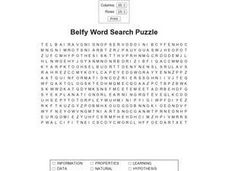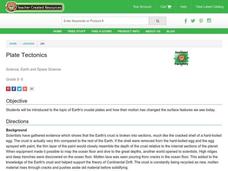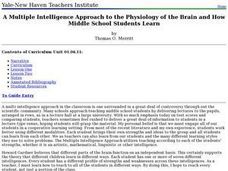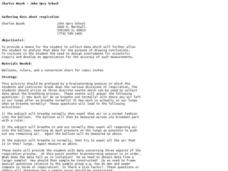Curated OER
Morphing
Students examine how organisms adapt to their environment in order to survive. As a class, they discuss the extinction of the dinosaurs and review Darwin's theory of survival of the fittest. They select an animal to morph in the future...
Curated OER
Laws of Motions
Seventh graders explore the Laws of Motion. They define friction and explain the concept of inertia. Students explain what happens when a force is exerted on an object that is in equilibrium. They state the second and third laws of motion.
Curated OER
Belfy Word Search
In this language arts worksheet, students study 20 words in a word bank, then locate them in a word search puzzle. The words appear to be related to chemistry but the meaning of the title is not known.
Curated OER
Teaching about Increased Conductivity: Are Culverts The Culprits?
Pupils encounter the complexity of identifying the cause of unusual variations in WOW conductivity data. They propose theories on why there was a sudden increase in conductivity in Ice Lake, Minnesota during July of 1998.
Curated OER
Color Principles - Hue, Saturation, and Value
Students identify different color models and the application of the color theory. They create different visualizations that compare color models.
Curated OER
Activity #6 How Fast Do Reactions Go?
Students name the factors (concentration, temperature, and a catalyst) which can affect the rate of a chemical reaction. They use their knowledge of particle theory to explain their observations. Pupils comprehend that the...
Curated OER
Simple Machines
First graders discuss work, force, and energy. They study how work is done. Students discuss various types of work that are done. They act out how work is done. Student draw pictures of types of work they have done.
Curated OER
The Earliest Primates
In this early primate worksheet, students will read information about the fossil evidence of the earliest primates. Students will complete 3 short answer questions based on their reading.
Curated OER
Sea Ice and Satellites
Young scholars study satellites and satellite images using Google Earth. In this satellite instructional activity, students discuss satellites and how they work. Young scholars watch a demonstration of how satellites work and learn what...
Curated OER
Schoolyard Field Guide
Fourth graders observe, plan, research, and create a field guide for the trees that are in their schoolyard. In this trees lesson plan, 4th graders make careful observations of what they see around their school and create a guide.
Curated OER
Fossils 1: Fossils and Dinosaurs
Students explain what can be learned from fossils and in doing so, realize the difference between fact and theory (idea). They also gain a general understanding of how fossils are formed.
Curated OER
NASA's Mars Gamble Pays Off Part 2
Tenth graders explore the planet of Mars. In this Earth Science lesson, 10th graders read articles on the make up of Mars. Students complete a worksheet on their reading.
Curated OER
Effects and Applications of Nuclear Chemistry
In this nuclear chemistry worksheet, students determine the biological effects and the applications of nuclear chemistry. Then students use Einstein's theory of special relativity to complete 3 problems.
Curated OER
The Ocean: A Watery World
Pupils discuss the proper clothing for the season. They make wind chimes to use as an indicator of movement of the air and observe and identify the various cloud formations. They determine the basic rules of storm safety and discuss...
Curated OER
Plate Tectonics
Students complete a data sheet. In this Earth composition lesson, students learn what happens when the Earth's plates push against each other. They watch a teacher demonstration and complete a data sheet.
Curated OER
A Multiple Intelligence Approach to the Physiology of the Brain and How Middle School Students Learn
Students draw a poster of a lateral view of the brain in order to label the different lobes of the brain. They examine what causes some people to be more musically intelligent than others. They dissect a cow's brain and label the...
Curated OER
Gathering Data About Respiration
Students engage in an experiment that tests how much air we breathe in and out during the respiration process. In this respiration lesson, students blow a typical breath's amount of air into a balloon. They use a ruler to measure the...
Curated OER
The Solar System
Students research origin of solar system, discuss theories they have found, and create paper mache solar system models.
Curated OER
The Declaration of War Against Japan and Just War Theory
High schoolers examine the attack on Pearl Harbor and how it changed the history of the United States. After watching a video from "The War", they discuss the characteristics of a "just war" and identify the laws in international...
Curated OER
Developing a Theory About the Nature of the Contents of a Sealed Box
Students observe the changes of a closed chemical system. They record and analyze the data as they manipulate the system. They answer questions to end the instructional activity.
Curated OER
Understanding Evolution: Homology and Analogy
In this understanding evolution worksheet, 9th graders define homology and analogy. Students compare and contrast similar structures in several given species.
Curated OER
Time and Earth History Socratic Questions
Students develop a sense of geologic ("deep") time and the ways in which Earth scientists construct the geologic time scale. They study he major events that shaped Earth, including the origin and evolution of its lithosphere, atmosphere,...
Curated OER
Biosphere Socratic Questions
Students examine the origin of life on Earth and its evolution through geologic time by participating in a whole class discussion. They respond to prompts that lead them to conclusions about the interactions among the biosphere and the...
Curated OER
Plate Tectonics
Students simulate the three types of plate boundaries using robots. In this earth science lesson, students explain how earthquakes and volcanoes are formed. They collect real-world earthquake data and plot them on the map.























